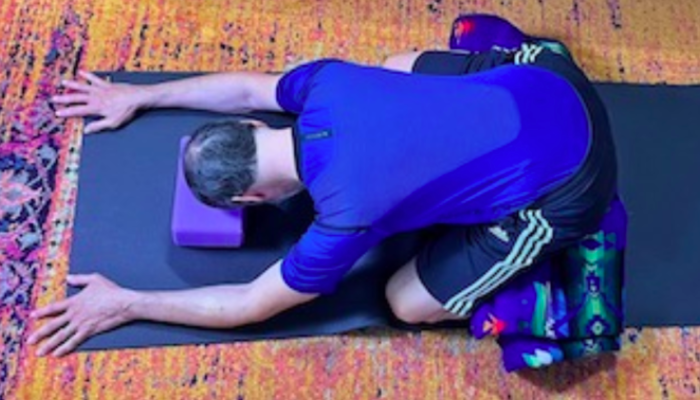I’ve long felt like a misfit in Child’s Pose.
This pose is perhaps the best-known restorative posture in yoga. And it’s often taught as if it’s supposed to be easy. Perhaps this is because the standard instructions are relatively simple: sit back on your heels, bend forward, and rest your head on your yoga mat.
Presumably, once you get into the pose, relaxation follows. But for me, Child’s Pose has been a bit stressful.
I’ve wondered, what’s the matter with me? Why do I feel strain in this pose, which, the name suggests, even a child can do?
I suppose an anatomically oriented answer is that my hamstrings aren’t all that loose and my spine isn’t all that supple.
But another answer, which became clear to me in a recent class in my yoga “sanctuary” is that I haven’t availed myself in this pose of two common yoga props: a block and a blanket. With these friendly props as aids, Child’s Pose can be centering, cooling, and connecting.
Centering
When I rest my head on a block instead of directly on the floor, my head feels centered on my neck and shoulders. My neck lengthens and my neck muscles soften. Without the block, I end up pushing my head down to touch the mat. My cervical spine, the spine of my neck, feels slightly kinked.
The way I situate my head on the block matters. What works best for me is to find a place on my forehead halfway between my hairline and my “third eye,” a spot between my eyebrows, to connect with the block and absorb its comfort.
When my head is restfully centered, I’m more at ease. My head, neck, and shoulders line up in a happy balance.
The centering sensation in my body seems to hold a broader lesson about finding center amidst the forward-leaning strain in my day-to-day life. Whether at my computer, driving in the car, or planning my next project, I often find that my head juts out in front of my shoulders and my neck is tight. It’s as if I’m pushing my brain ahead of my body rather than bringing my body and mind together to engage with life’s tasks.
But as I write this piece at my desktop computer, I can reimagine the centeredness of Child’s Pose and feel the gentle support of an imaginary block behind my head. As I nestle the back of my skull into the block in my mind’s eye, I’m encouraged to glide my earlobes back, lift the crown of my head, and relax the muscles of my neck and throat. I can remember to smile even while managing serious matters. I can allow the natural ease of a child to join with my adult self in facing whatever it is that awaits me.
Cooling
Resting and centering my head on a block in Child’s Pose not only eases muscle tension, it smooths and cools my breath.
What I find especially cooling is to feel my in-breath washing up against the outer edges of my nostrils. This softly flares out my nostrils and sends a pleasing, tickling sensation up to my inner eyelids.
On the exhalation, my breath sweeps smoothly down along the inside of my nostrils, following the point of my nose. My nervous system slows down.
The heat of life activity gets a chance to cool in the wash and sweep of the breath.
What heightens this cooling sensation for me is to let my head slowly rock back and forth on the block. As my forehead tilts slightly upward, I inhale. As my forehead tilts slightly downward, I exhale. Syncing the head-rocking action with my breath is further calming while also adding a bit of rhythmic movement to the pose.
Connecting
Part of the value of Child’s Pose is to feel a sense of grounding in the earth as you sit back on your heels. When my hips close the connection with my heels, I’m held snugly in gravity’s embrace.
What helps me to sit fully back is to place a folded blanket under my back thighs. Without the blanket, I struggle to link my pelvis with my heels; my sit bones hover in blank, groundless space. With a blanket, the blank space fills with supportive, cushiony fabric.
The last several times I did Child’s Pose, I found myself reaching for a blanket that holds special meaning for me. This was a beautiful wool blanket with a Native American design, made in my adopted state, Oregon, that my physical therapist and friend gave me. My friend is an American Indian whose family traces its lineage to Indigenous peoples living along the Columbia River. With my friend’s cultural heritage reflected in the blanket’s design, the gift was much more than a prop. It was a symbol of connection with my friend and of her community.
As I added this blanket to my Child Pose experience, I thought back to the many physical therapy visits when I received such caring and expert attention from my friend. I thought, too, of the healing she helped me to realize and the spirit of friendship that has flowed between us for more than a decade.
The longer I do yoga, the more I see that the props I use, the setting I create, and the symbolic crafts and artwork that surround me can deepen my experience of the beauty and benevolence that abound in our midst.
The simple prop of a blanket, with the companion resource of a block, has heightened my appreciation for both the gifts of the body and the connections with people and experiences I hold dear.
Author’s acknowledgments: I’d like to tip my hat to Leslie Ellis, my longtime yoga teacher and founder of the Heartsong Yoga Sanctuary. I’d also like to express my gratitude to Kasey Stewart, a yoga-teaching friend and fellow member of the Sanctuary who provided invaluable feedback on an earlier draft of this article.












Read 12 comments and reply